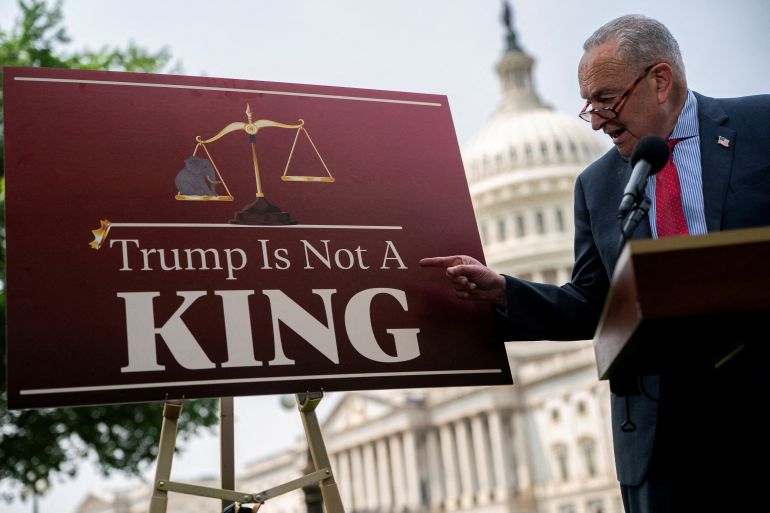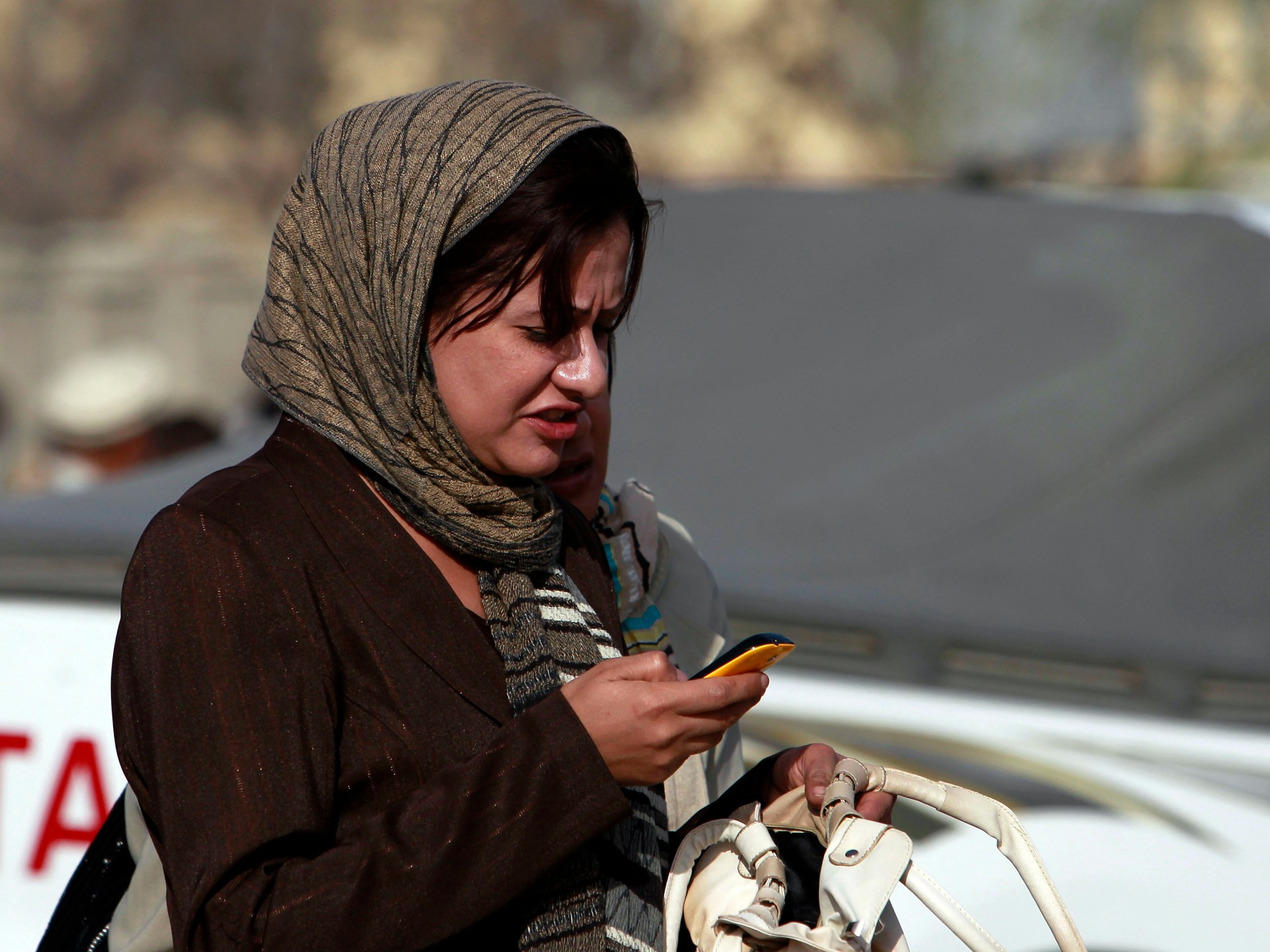The United States government will shut down on Wednesday if Democrats and Republicans in Congress cannot reach an agreement on a vital funding bill.
The shutdown could temporarily halt some US government services and put the salaries of government employees on hold – or even end them altogether.
Recommended Stories
list of 4 itemsend of list
While it has been normal practice to place staff on “furlough” during previous government shutdowns – meaning they are reinstated and receive back pay once the government is up and running again – this time, the Trump administration is threatening to fire people permanently.
Why might the government shut down?
The new fiscal year for the federal government begins on October 1, but Congress has not agreed on a necessary short-term funding bill.
Republicans control both chambers of Congress.
In the Senate, Republicans hold 53 seats and Democrats, 47. The Republicans have fallen short of the 60 votes needed to pass legislation. The Senate majority leader is Republican John Thune, and the minority leader is Democrat Chuck Schumer.
In the House of Representatives, Republicans hold 220 seats and Democrats hold 212. The House speaker is Republican Mike Johnson, the majority leader is Republican Steve Scalise, and the minority leader is Democrat Hakeem Jeffries.
The disagreement is over a short-term spending bill introduced by the Republicans, lays out the funding of government operations until November 21. Without it, the government cannot function.
What is the dispute about, exactly?
The main stumbling block is continued funding for the Affordable Care Act, also called Obamacare, which is popular with voters and enables low-income people to access healthcare, John Owens, an emeritus professor of US government and politics at the University of Westminster in London, told Al Jazeera.
Democrats are refusing to back the Republican bill unless Republicans undo recent cuts to Medicaid enacted under Trump’s “One Big Beautiful Bill” in July.
Democrats additionally want to extend special tax credits that reduce the cost of health insurance for Americans. These credits are set to expire later this year.
Therefore, Senate Democrats have proposed a range of alternatives, including a seven- to 10-day funding bill, along with other possible measures that could run concurrently, two Senate Democratic sources told the Reuters news agency on Monday.
Republicans have rejected these proposals, however, and, so far, neither side shows any sign of backing down. Earlier this week, US President Donald Trump cancelled talks with Democratic leaders, deeming their demands “unserious”.
As a result, Congress is in limbo and is not expected to vote on anything this week.
On Monday, congressional leaders left a meeting with Trump without reaching a deal. Schumer and Jeffries have blamed the Republicans for the impending shutdown.
Hours after that meeting, Trump posted an AI-generated, “deepfake” video of Schumer and Jeffries with fabricated audio on his Truth Social platform. It depicts Jeffries wearing a large sombrero and sporting a handlebar moustache while Schumer says, “If we give all these illegal aliens healthcare, we might be able to get them on our side so they can vote for us.”
The video has been condemned by Democrats as a racist dogwhistle alluding to Mexicans. “It’s a disgusting video and we’re gonna continue to make clear bigotry will get you nowhere,” Jeffries said. “We are fighting to protect the healthcare of the American people in the face of an unprecedented Republican assault.”
How likely is it that there will be a government shutdown?
The disagreement over healthcare funding is far from being resolved. Furthermore, Owens explained that any Senate agreement must also be approved by the House, where Trump’s party has a slim, hard-right majority closely aligned with him. However, some Republicans in the House are also fearful of the effects of the healthcare cuts in their districts.
“With midterm elections due next November, there is tremendous pressure, particularly on electorally vulnerable Republican senators who are also under pressure from Trump to support his cuts,” Owens said.
“Whether the current impasse results in a shutdown remains to be seen. Its effects will depend on its length and the ultimate willingness of Trump and his party, and the Congressional Democrats to reach some kind of compromise.”
Trump himself does not seem optimistic about resolving the impasse. “I just don’t know how we’re going to solve this issue,” CBS News reported, quoting him, on Sunday.
US Vice President JD Vance also warned that the government is heading for a shutdown, blaming Democrats. “I think we’re headed into a shutdown because the Democrats won’t do the right thing,” Vance told reporters after the meeting on Monday.
If Congress does not agree on a short-term funding bill by midnight on Tuesday (04:00 GMT on Wednesday), the shutdown will prompt federal closures at 12:01am on Wednesday (04:01 GMT).
On Tuesday, the crypto-based prediction market, Polymarket, placed the odds of a government shutdown at 86 percent.
What happens during a government shutdown?
A government shutdown happens when a lapse in funding forces parts of the government federal agencies with non-essential functions to cease operations.
Under US law, if the government shuts down, agencies are required to “furlough” – suspend or discharge – their “non-excepted” employees. Once the shutdown is over and operations resume, furloughed employees receive their backdated pay, due to a 2019 bill passed by Congress enshrining this into law.
An “excepted employee” is a US federal civil service employee who “protects life and property”. While excepted employees stay on the job during a government shutdown, they do not get paid until the shutdown ends.
Each agency develops its own plan for the shutdown, deciding which employees will stay and who will be furloughed.
Owens estimated that about 900,000 federal workers would be laid off if the shutdown happens.
Some government work continues during a shutdown. Members of the armed forces, FBI, CIA and air traffic controllers continue to work.
Programmes funded by mandatory spending, such as Social Security and Medicare, also continue during a shutdown.
The US Postal Service, which is not funded by tax money, continues operations during a shutdown.
Has the US government shut down before?
Yes, most recently during Trump’s first term as president.
Two years into Trump’s first term, in December 2018, Congress could not reach an agreement on federal funding, prompting a 35-day partial shutdown, the longest in modern US history.
This caused the complete or partial shutdown of nine federal departments: Agriculture, Commerce, Homeland Security, Housing and Urban Development, Interior, Justice, State, Transportation and Treasury.
Trump had demanded that Congress give him money for the construction of a border wall between the US and Mexico. The House speaker at the time was Democrat Nancy Pelosi, who did not agree with this. Trump retreated after 35 days. During this standoff, approximately 340,000 of the 800,000 federal workers at affected agencies were furloughed.
During the administration of Democratic President Barack Obama, there was a 16-day government shutdown in October 2013. This shutdown was pushed by hard-right House Republicans who insisted that Obamacare should be blocked in the spending bill. The shutdown was resolved following bipartisan talks in the Senate – again, Republicans’ demands were not met.
The US has also experienced government shutdowns in the 1970s, 80s and 90s, under Democratic President Bill Clinton, Democrat Jimmy Carter and Republican President Ronald Reagan, who experienced eight shutdowns.
What is different this time?
This time, the White House’s Office of Management and Budget (OMB) has sent out a memo on September 24 instructing government agencies to prepare for large-scale layoffs of federal workers if the government shuts down. Agencies must send their proposed staff reduction plans to the OMB and notify employees if a shutdown occurs.
This is a more aggressive move compared with previous shutdowns, when furloughed employees would be reinstated after government operations resumed. In this case, these federal employees will be fired permanently and will not be reinstated after government operations are resumed.
Democratic leaders in Congress condemned the memo. “This is an attempt at intimidation,” Schumer wrote in response to the memo on X on September 25. Jeffries responded as well, posting on X on the same day: “We will not be intimidated by your threat to engage in mass firings.”
What else could be impacted by this?
If the shutdown takes place on Wednesday, the monthly jobs report from the Bureau of Labor Statistics (BLS), which is to be released on Friday, is likely to be delayed because the BLS is one of the agencies to be closed.
Key data about inflation, which was set to be released in mid-October, could also be delayed.





